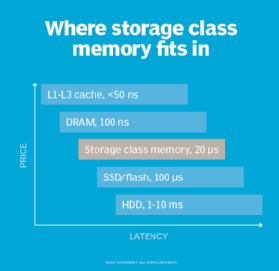RRAM or ReRAM (resistive random access memory)
What is RRAM or ReRAM (resistive random access memory)?
RRAM, also known as resistive random access memory or ReRAM, is a form of non-volatile storage that operates by changing the resistance of a specially formulated solid dielectric material. An RRAM device contains a component called a memristor -- a contraction of memory resistor -- where the resistance varies from a high-resistance state to a low-resistance state when different voltages are imposed across it.
Normally, a dielectric material doesn't conduct electric current. In fact, dielectric substances are used in capacitors for the specific purpose of preventing the flow of current and maintaining separation of electric charge poles. If a sample of dielectric material is subjected to a high enough voltage, it suddenly conducts because of a phenomenon called dielectric breakdown.
In conventional dielectric material, breakdown causes permanent damage and failure of the associated component. In a memristor, the dielectric breakdown is temporary and reversible because of the materials used.
How does a memristor work?
Resistive RAM has a resistive switching memory cell with a metal-insulator-metal structure. These RRAM cells use a method of creating physical defects in a layer of metal oxide material. These defects are called oxygen vacancies. The vacancies represent two values in a binary system. RRAM works like a semiconductor, which uses electrons and holes to create the binary system rather than oxygen ions.
In one form of memristor, a deliberately applied operating voltage causes the medium to acquire microscopic conductive paths called filaments. Filaments result from various phenomena, such as metal migration or physical defects. Once a filament appears, a different external voltage can be used to break or reverse it.
The controlled formation and destruction of filaments in large numbers enable the digital data retention and data storage. Numerous substances have been tested for memristor characteristics, including nickel oxide, titanium dioxide, various electrolytes, semiconductor materials and even some organic compounds.
Another memristive form uses voltage to cause a change in the state of an amorphous solid called chalcogenide glass. This technique flips chalcogenide glass rapidly from a hardened state to a more fluidlike state, changing the resistance of the material.
Applications of RRAM technology
RRAM memory and storage devices are available; however, their use hasn't gathered momentum. Typical use cases involve requirements for non-volatile memory (NVM) and storage, including high speed, low latency, low power use and durability. Among frequently cited applications are artificial intelligence (AI), machine learning and the internet of things (IoT).

Storage class memory (SCM) is envisioned as a bridge between existing storage technologies and main memory. It uses non-volatile NAND solid-state memory with its speed, hard disk drive technology and storage capacities to provide options for existing flash memory and storage devices. The use of RRAM technology in lieu of NAND could become an important application.
RRAM pros and cons
Higher switching speed is the principal advantage of RRAM over other non-volatile storage technologies, such as NAND flash. Timescales as short as 10 nanoseconds have been observed. Memristor filaments can occur in dimensions as small as a few nanometers, a tiny fraction of the wavelength of visible light in free space, offering the promise of high storage density. The occasional formation of unintended filaments, called sneak paths, presents a challenge for engineers intent on the large-scale development of memristor technology and RRAM devices.
RRAM and other memristor technologies also draw much less power than NAND flash. That makes them well suited for memory in sensor devices for industrial, automotive and IoT applications. As the cost of manufacturing RRAM and other memristors drops, they're expected to become competitive with NAND flash.
High-density memory, fast read/write speeds and low power consumption are reasons why memristor-based memory technologies are among the most anticipated replacements in applications like solid-state drives (SSDs) and non-volatile dual in-line memory modules, or NVDIMMs. Several companies make RRAM chipsets and memory units. However, costs must decline for the technology to compete with existing NVM and storage systems.
Other memristor technologies
In addition to RRAM, other memristor technologies in various stages of development or market presence include conductive-bridging RAM (CBRAM) and phase-change memory (PCM).
CBRAM uses a layer of electrolytic material through which the conductive filaments are created and destroyed. The resistance in the dielectric material decreases or increases based on whether the filament exists or not. This technology is available from Adesto Technologies as ultra-low-power memory components and electronic devices for IoT applications.
In contrast, PCM applies a current to the dielectric material to change the state of chalcogenide glass from more solid to less solid. Initially, the development was focused on finding the best material for achieving these two states. More recent work is focused on allowing the material to hold multiple states of variable levels of crystalline or amorphous states.
Who makes RRAM?
Sharp Corporation owns the registered trademark "RRAM" in several countries. According to TechTarget research and RRAM-info, vendors manufacturing RRAM-based chipsets and memory devices include the following:
- 4DS Memory launched in 2007 in Perth, Australia, to develop nonfilamentary RRAM-based memory for next-generation gigabyte storage in mobile devices and cloud services.
- Adesto Technologies is part of Renasas Electronics. Adesto launched in 2007 in Santa Clara, Calif., to develop CBRAM and make ultra-low-power memory components for IoT systems.
- CrossBar was founded in 2010 and headquartered in Santa Clara, Calif. It develops filament-based RRAM-based memory chips with capacities of 1 terabyte and potentially higher.
- Fujitsu Semiconductor is one of the world's largest IT providers and the largest one in Japan where it's based. Its RRAM product line includes the 8 megabyte MB85AS8MT and 12 MB MB85AS12MT memory chipsets.
- InnoStar Semiconductor, based in Shanghai, develops advanced memory technologies, including RRAM. ByteDance, the owner of TikTok, bought a stake in InnoStar early in 2024 as an investment for developing components for its virtual reality systems.
- Panasonic launched the first RRAM-based device in 2013, with the MN101LR series that was used in 8-bit microcomputers. In 2017, Panasonic partnered with United Microelectronics, a global semiconductor foundry, to develop next-generation RRAM memory.
- SanDisk, owned by Western Digital, develops RRAM memory and has been developing 3D RRAM in SCM to be used in high-performance SSDs.
- Weebit Nano was founded in 2015 in Israel. The company develops and manufactures RRAM technology for use in a variety of applications, including IoT, industrial systems, and AI-based drones and robotics.
The future of RRAM technology
RRAM technology is being built into a variety of devices. However, the popularity of NAND and other NVM technologies means that RRAM is still working to establish itself. Factors impacting the future of RRAM technology include the following:
- Advancements in materials and scalability. Materials used in RAM technology are being updated to enhance performance and scalability. Semiconductor manufacturing processes are currently more efficient.
- SCM. SCM is a blend of technologies, and RRAM is increasingly likely to be a player, based on its non-volatility and fast access times.
- Challenges to overcome. Among the key challenges for RRAM going forward are boosting retention, creating long endurance to increase the number of write cycles, improving cost-effectiveness relative to other current technologies and ensuring the reliability of RRAM components.
- Industry acceptance. Although RRAM isn't fully in the mainstream of technology options, it makes a compelling case. Many organizations are investing in its development.
- Beyond memory and storage. RRAM's unique capabilities might be used in applications other than memory and storage, such as in-memory computing and simulation of neural networks.
The many organizations committed to RRAM must overcome technology hurdles, boost cost-effectiveness, establish viable use cases and characterization, and convince the semiconductor industry of its value. Progress in those areas will enable RRAM to play an important role in next-generation storage and memory applications and systems.
Flash memory plays a key role in enterprise storage. Learn about flash architecture, types and products in our comprehensive flash memory guide.







